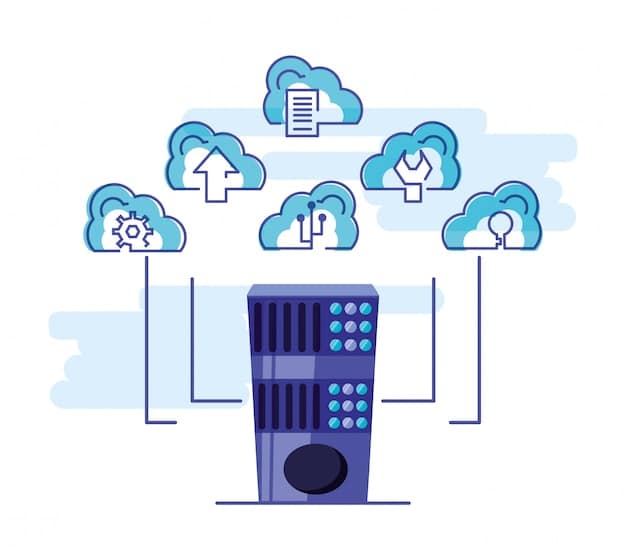Cloud Cost Optimization: Reduce Waste by 20% in 6 Months

Cloud cost optimization strategies are essential for businesses aiming to reduce cloud spending waste by 20% within six months through methods like rightsizing resources, utilizing automation, and continually monitoring cloud usage.
Are you looking to cut your cloud spending without compromising performance? Implementing effective cloud cost optimization strategies: reducing waste by 20% in 6 months is possible with the right approach. Let’s explore how.
Understanding Cloud Cost Optimization
Cloud cost optimization is the process of reducing your overall cloud spending by identifying and eliminating waste. It involves implementing strategies to ensure you’re only paying for the resources you actually need and use.
Many organizations overspend on cloud resources due to a lack of visibility into their usage or inefficient resource allocation. Understanding the root causes of this overspending is the first step toward effective optimization.
Common Causes of Cloud Overspending
Several factors can contribute to uncontrolled cloud costs. Identifying these is crucial for developing targeted optimization strategies.
- Idle Resources: Resources that are provisioned but not actively used, such as unused virtual machines or storage volumes.
- Over-Provisioning: Allocating more resources than needed, like using larger instance sizes when smaller ones would suffice.
- Lack of Visibility: Inadequate monitoring and reporting tools that prevent you from seeing where your money is being spent.
- Inefficient Scaling: Not scaling resources up or down based on demand, leading to wasted resources during off-peak hours.
Addressing these common issues can significantly impact your cloud spending, leading to substantial savings and improved resource utilization.
In conclusion, comprehending the underlying factors behind cloud overspending is foundational for implementing successful optimization measures that directly address these issues.
Key Strategies for Cloud Cost Reduction
Once you understand the causes of cloud cost overspending, you can employ various strategies to address them. These strategies can help you reduce waste and optimize your cloud spend.
These strategies can be implemented individually or in combination to achieve the best results for your organization. Regular monitoring and adjustments are essential to maintain optimal cost efficiency.

Rightsizing Resources
Rightsizing involves matching your resources to your actual workload requirements. This prevents over-provisioning and ensures you’re not paying for unused capacity.
Tools and services are available to help analyze your resource utilization and provide recommendations for rightsizing your instances and other resources.
Leveraging Reserved Instances and Spot Instances
Reserved Instances (RIs) offer significant cost savings compared to on-demand pricing. Spot Instances provide even greater discounts but come with the risk of interruption.
By leveraging Reserved Instances for predictable workloads and Spot Instances for fault-tolerant tasks, you can achieve substantial cost reductions without sacrificing performance.
- Reserved Instances: Commit to using resources for a specific term (e.g., one or three years) in exchange for a discounted rate.
- Spot Instances: Bid on unused capacity at deeply discounted prices, ideal for non-critical workloads.
- Savings Plans: A flexible pricing model that offers savings based on compute usage, regardless of instance type or region.
To summarize, using Reserved and Spot Instances strategically optimizes cloud spending by leveraging discounted pricing models, suitable for distinct workload needs, such as predictable versus fault-tolerant tasks.
Implementing Automation for Cost Efficiency
Automation plays a crucial role in optimizing cloud costs by streamlining resource management and ensuring efficient utilization. Automation tools can help you scale resources automatically, shut down idle instances, and enforce cost policies.
Adopting automation not only reduces your cloud bill but also frees up your IT team to focus on more strategic initiatives, driving further value for your organization.

Automated Scaling
Automated scaling allows you to automatically adjust your resource allocation based on demand, ensuring you have enough capacity during peak times and reducing waste during off-peak hours.
Tools like AWS Auto Scaling and Azure Autoscale can help you set up rules to automatically scale your resources up or down based on metrics like CPU utilization or network traffic.
Shutdown Idle Instances
Idle instances are a significant source of cloud waste. Automating the shutdown of these instances can help you save a considerable amount of money.
Scripts and tools can be used to identify idle instances and automatically shut them down after a certain period of inactivity, ensuring you’re not paying for unused resources.
- Identifying Idle Resources: Use monitoring tools to detect resources with low utilization.
- Automated Shutdown Scripts: Implement scripts that automatically shut down idle instances after a predefined period.
- Notification Systems: Set up notifications to alert stakeholders before instances are shut down.
Altogether, automation enhances cloud cost efficiency by dynamically adjusting resource allocation based on demand, ensuring maximum utilization and minimizing waste from idle assets.
Monitoring and Reporting Cloud Costs
Effective monitoring and reporting are essential for tracking your cloud spending and identifying areas for further optimization. By monitoring your cloud resources, you can gain insights into your usage patterns and identify potential cost-saving opportunities.
Regular reporting provides a clear overview of your cloud spend, allowing you to make informed decisions and continuously improve your cost optimization efforts.
Setting Up Cost Monitoring Tools
Cloud providers offer various cost monitoring tools that provide detailed visibility into your spending. These tools can help you track your costs, identify trends, and set budgets.
AWS Cost Explorer, Azure Cost Management, and Google Cloud Cost Management are examples of tools that can help you monitor your spending and identify cost optimization opportunities.
Generating Cost Reports
Regular cost reports provide a comprehensive overview of your cloud spend, allowing you to track your progress and identify areas for improvement. These reports should include key metrics such as total spend, cost per service, and resource utilization.
Automated reporting tools can generate these reports on a regular basis, ensuring you have up-to-date information to make informed decisions about your cloud spending.
- Budgeting: Establish budgets for each service and track your spending against these budgets.
- Real-time Monitoring: Set up real-time alerts to notify you of unexpected cost spikes.
- Trend Analysis: Analyze historical cost data to identify trends and forecast future spending.
In essence, comprehensive cloud cost monitoring and reporting equip organizations with the visibility needed to track spending, identify patterns, and make well-informed decisions for continuous cost improvement.
Organizational Strategies for Cost Awareness
Creating a culture of cost awareness throughout your organization is crucial for successful cloud cost optimization. By involving all stakeholders in the cost optimization process, you can ensure that everyone is working towards the same goal.
Encouraging collaboration, providing training, and establishing clear cost policies can help foster a cost-conscious culture and drive sustainable cost savings.
Establishing Cost Policies
Clear cost policies provide guidelines for how cloud resources should be used and managed. These policies should address topics such as resource provisioning, scaling, and decommissioning.
By establishing clear cost policies, you can ensure that everyone in your organization is aware of their responsibilities and understands how their actions impact cloud spending.
Training and Education
Providing training and education to your IT team and other stakeholders can help them understand the principles of cloud cost optimization and how to implement cost-saving strategies. This training should cover topics such as rightsizing, automation, and monitoring.
Well equipped team can find more opportunities for cost reductions.
- Cross-functional Collaboration: Encourage collaboration between IT, finance, and business teams.
- Continuous Improvement: Foster a culture of continuous improvement, where cost optimization is an ongoing process.
- Regular Cost Reviews: Conduct regular cost reviews to identify new opportunities for savings.
In conclusion, cultivating cost awareness through clear policies, training, and collaboration ensures that everyone in the organization is aligned and actively contributes to continuous cloud cost optimization.
Tools and Technologies for Cost Optimization
Numerous tools and technologies can help you optimize your cloud costs. These tools range from native cloud provider services to third-party solutions that offer more advanced features and capabilities.
Selecting the right tools depends on your specific needs and requirements. This tools will help to automate your environment.
Cloud Provider Native Tools
Cloud providers offer a range of native tools for monitoring and managing costs. These tools are typically included as part of your cloud subscription and provide basic cost visibility and optimization capabilities.
AWS Cost Explorer, Azure Cost Management, and Google Cloud Cost Management are examples of native tools that can help you track your spending and identify cost optimization opportunities.
Third-Party Cost Optimization Platforms
Third-party cost optimization platforms offer more advanced features and capabilities than native cloud provider tools. These platforms can provide deeper insights into your cloud spending, automate cost optimization tasks, and provide recommendations for reducing waste.
CloudHealth, Flexera, and CloudCheckr are examples of third-party cost optimization platforms that can help you maximize your cloud ROI.
- Cost Visibility: Tools that provide detailed visibility into your cloud spending.
- Automation: Tools that automate cost optimization tasks, such as rightsizing and shutting down idle instances.
- Recommendations: Tools that provide recommendations for reducing waste and optimizing your cloud spend.
Briefly, both cloud provider-native and third-party cost optimization tools offer distinct advantages, with native tools providing basic visibility and third-party platforms delivering advanced automation and insights for greater ROI.
| Key Point | Brief Description |
|---|---|
| 💡 Rightsizing | Match resources to actual needs to avoid over-provisioning. |
| ⚙️ Automation | Automate scaling and shutdown of idle instances to reduce waste. |
| 📊 Monitoring | Use tools to track spending and identify cost-saving opportunities. |
| 🤝 Cost Culture | Encourage cost awareness throughout the organization. |
FAQ
Cloud cost optimization strategies are methods used to reduce unnecessary cloud spending while maintaining or improving performance. They focus on eliminating waste and improving resource utilization.
Rightsizing involves matching your resources to your actual workload requirements. This prevents over-provisioning, ensuring you only pay for the capacity you need, thus reducing costs.
Automation streamlines resource management, scales resources dynamically, and shuts down idle instances. This ensures efficient utilization and reduces waste, leading to significant cost savings.
Monitoring provides insights into your cloud spending, helping identify trends and areas for improvement. Regular monitoring allows you to track progress and make informed decisions about resource allocation.
Create clear cost policies, provide training and education, and encourage collaboration between teams. This promotes a culture where everyone understands their role in optimizing cloud spending.
Conclusion
Implementing effective cloud cost optimization strategies: reducing waste by 20% in 6 months is achievable with the right combination of strategies, tools, and organizational awareness. By focusing on rightsizing, automation, monitoring, and a cost-conscious culture, businesses can significantly reduce their cloud spending while maintaining optimal performance. Start today and unlock substantial savings.





